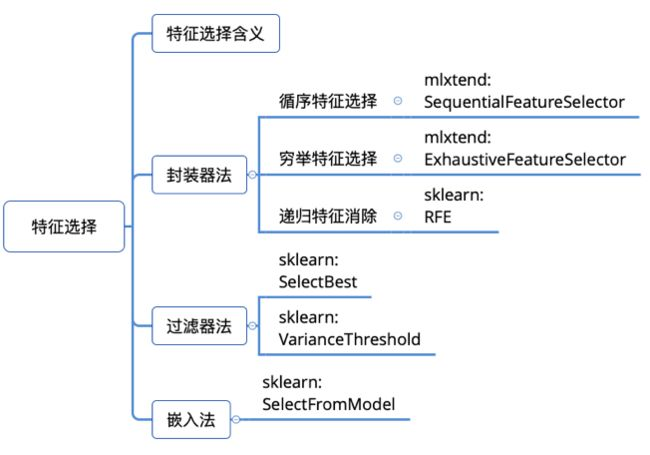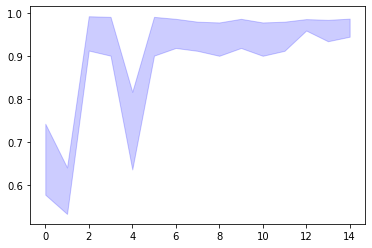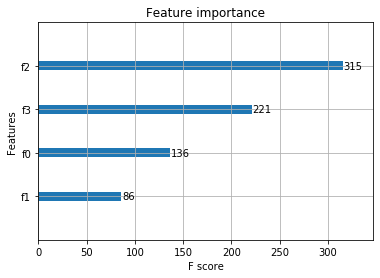mlxtend.feature_selection 特征工程
特征选择

主要思想:包裹式(封装器法)从初始特征集合中不断的选择特征子集,训练学习器,根据学习器的性能来对子集进行评价,直到选择出最佳的子集。包裹式特征选择直接针对给定学习器进行优化
案例一、封装器法

常用实现方法:循序特征选择。
- 循序向前特征选择:Sequential Forward Selection,SFS
- 循序向后特征选择:Sequential Backword Selection,SBS
SFS过程展示图:

例子:
SequentialFeatureSelector(estimator, K_features=1, forvard=Truer, floating=False, verhose=o , scoring=None, cv=5, n_jobs=1, pre_dispatch-=2*n_jobs, clone_estimator=True)
加载数据集
#加载数据集 from mlxtend.feature_selection import SequentialFeatureSelector as SFS #SFS from mlxtend.data import wine_data #dataset from sklearn.neighbors import KNeighborsClassifier from sklearn.model_selection import train_test_split from sklearn.preprocessing import StandardScaler X, y = wine_data() X.shape #(178, 13)
数据预处理
#数据预处理 X_train, X_test, y_train, y_test= train_test_split(X, y, stratify=y, test_size=0.3, random_state=1) std = StandardScaler() X_train_std = std.fit_transform(X_train)
循序向前特征选择
#循序向前特征选择 knn = KNeighborsClassifier(n_neighbors=3) sfs = SFS(estimator=knn, k_features=4, forward=True, floating=False, verbose=2, scoring='accuracy', cv=0) sfs.fit(X_train_std, y_train) #xy不能是df
查看特征索引
#查看特征索引 sfs.subsets_
{1: {'feature_idx': (6,),
'cv_scores': array([0.86290323]),
'avg_score': 0.8629032258064516},
2: {'feature_idx': (6, 9),
'cv_scores': array([0.95967742]),
'avg_score': 0.9596774193548387},
3: {'feature_idx': (6, 9, 11),
'cv_scores': array([0.99193548]),
'avg_score': 0.9919354838709677},
4: {'feature_idx': (6, 8, 9, 11),
'cv_scores': array([0.98387097]),
'avg_score': 0.9838709677419355}}
可视化#1 Plotting the results
%matplotlib inline from mlxtend.plotting import plot_sequential_feature_selection as plot_sfs fig = plot_sfs(sfs.get_metric_dict(), kind='std_err')

其中 sfs.get_metric_dict()的结果如下:
{1: {'feature_idx': (6,),
'cv_scores': array([0.86290323]),
'avg_score': 0.8629032258064516,
'ci_bound': nan,
'std_dev': 0.0,
'std_err': nan},
2: {'feature_idx': (6, 9),
'cv_scores': array([0.95967742]),
'avg_score': 0.9596774193548387,
'ci_bound': nan,
'std_dev': 0.0,
'std_err': nan},
3: {'feature_idx': (6, 9, 11),
'cv_scores': array([0.99193548]),
'avg_score': 0.9919354838709677,
'ci_bound': nan,
'std_dev': 0.0,
'std_err': nan},
4: {'feature_idx': (6, 8, 9, 11),
'cv_scores': array([0.98387097]),
'avg_score': 0.9838709677419355,
'ci_bound': nan,
'std_dev': 0.0,
'std_err': nan}}
可视化#2 Selecting the “best” feature combination in a k-range
knn = KNeighborsClassifier(n_neighbors=3) sfs2 = SFS(estimator=knn, k_features=(3, 10), forward=True, floating=True, verbose=0, scoring='accuracy', cv=5) sfs2.fit(X_train_std, y_train) fig = plot_sfs(sfs2.get_metric_dict(), kind='std_err')

全部代码如下:

# -*- coding: utf-8 -*- """ Created on Tue Aug 11 10:12:48 2020 @author: Admin """ #加载数据集 from mlxtend.feature_selection import SequentialFeatureSelector as SFS #SFS from mlxtend.data import wine_data #dataset from sklearn.neighbors import KNeighborsClassifier from sklearn.model_selection import train_test_split from sklearn.preprocessing import StandardScaler X, y = wine_data() X.shape #(178, 13) #数据预处理 X_train, X_test, y_train, y_test= train_test_split(X, y, stratify=y, test_size=0.3, random_state=1) std = StandardScaler() X_train_std = std.fit_transform(X_train) #循序向前特征选择 knn = KNeighborsClassifier(n_neighbors=3) sfs = SFS(estimator=knn, k_features=4, forward=True, floating=False, verbose=2, scoring='accuracy', cv=0) sfs.fit(X_train_std, y_train) #查看特征索引 sfs.subsets_ #可视化#1 Plotting the results %matplotlib inline from mlxtend.plotting import plot_sequential_feature_selection as plot_sfs fig = plot_sfs(sfs.get_metric_dict(), kind='std_err') #可视化#2 Selecting the “best” feature combination in a k-range knn = KNeighborsClassifier(n_neighbors=3) sfs2 = SFS(estimator=knn, k_features=(3, 10), forward=True, floating=True, verbose=0, scoring='accuracy', cv=5) sfs2.fit(X_train_std, y_train) fig = plot_sfs(sfs2.get_metric_dict(), kind='std_err')
案例二、封装器之穷举特征选择
穷举特征选择(Exhaustive feature selection),即封装器中搜索算法是将所有特征组合都实现一遍,然后通过比较各种特征组合后的模型表现,从中选择出最佳的特征子集
导入相关库
#导入相关库 from mlxtend.feature_selection import ExhaustiveFeatureSelector as EFS from sklearn.neighbors import KNeighborsClassifier from sklearn.datasets import load_iris
加载数据集
#加载数据集 iris = load_iris() X = iris.data y = iris.target
穷举特征选择
#穷举特征选择 knn = KNeighborsClassifier(n_neighbors=3) # n_neighbors=3 efs = EFS(knn, min_features=1, max_features=4, scoring='accuracy', print_progress=True, cv=5) efs = efs.fit(X, y)
查看最佳特征子集
#查看最佳特征子集 print('Best accuracy score: %.2f' % efs.best_score_) #Best accuracy score: 0.97 print('Best subset(indices):', efs.best_idx_) #Best subset(indices): (0, 2, 3) print('Best subset (correponding names):', efs.best_feature_names_) #没有这个函数
度量标准
#度量标准 efs.get_metric_dict() import pandas as pd df = pd.DataFrame.from_dict(efs.get_metric_dict()).T df.sort_values('avg_score', inplace=True, ascending=False) df
可视化
#可视化 import matplotlib.pyplot as plt # 平均值 metric_dict = efs.get_metric_dict() k_feat = sorted(metric_dict.keys()) avg = [metric_dict[k]['avg_score'] for k in k_feat] # 区域 fig = plt.figure() upper, lower = [], [] for k in k_feat: #bound upper.append(metric_dict[k]['avg_score'] + metric_dict[k]['std_dev']) lower.append(metric_dict[k]['avg_score'] - metric_dict[k]['std_dev']) plt.fill_between(k_feat, upper, lower, alpha=0.2, color='blue', lw=1) # 折线图 plt.plot(k_feat, avg, color='blue', marker='o') # x, y 轴标签 #无法运行 ''' plt.ylabel('Accuracy +/- Standard Deviation') plt.xlabel('Number of Features') feature_min = len(metric_dict[k_feat[0]]['feature_idx']) feature_max = len(metric_dict[k_feat[-1]]['feature_idx']) plt.xticks(k_feat, [str(metric_dict[k]['feature_names']) for k in k_feat], rotation=90) plt.show() '''


全部代码如下:

# -*- coding: utf-8 -*- """ Created on Tue Aug 11 10:12:48 2020 @author: Admin """ #导入相关库 from mlxtend.feature_selection import ExhaustiveFeatureSelector as EFS from sklearn.neighbors import KNeighborsClassifier from sklearn.datasets import load_iris #加载数据集 iris = load_iris() X = iris.data y = iris.target #穷举特征选择 knn = KNeighborsClassifier(n_neighbors=3) # n_neighbors=3 efs = EFS(knn, min_features=1, max_features=4, scoring='accuracy', print_progress=True, cv=5) efs = efs.fit(X, y) #查看最佳特征子集 print('Best accuracy score: %.2f' % efs.best_score_) #Best accuracy score: 0.97 print('Best subset(indices):', efs.best_idx_) #Best subset(indices): (0, 2, 3) print('Best subset (correponding names):', efs.best_feature_names_) #没有这个函数 #度量标准 efs.get_metric_dict() import pandas as pd df = pd.DataFrame.from_dict(efs.get_metric_dict()).T df.sort_values('avg_score', inplace=True, ascending=False) df #可视化 import matplotlib.pyplot as plt # 平均值 metric_dict = efs.get_metric_dict() k_feat = sorted(metric_dict.keys()) avg = [metric_dict[k]['avg_score'] for k in k_feat] # 区域 fig = plt.figure() upper, lower = [], [] for k in k_feat: #bound upper.append(metric_dict[k]['avg_score'] + metric_dict[k]['std_dev']) lower.append(metric_dict[k]['avg_score'] - metric_dict[k]['std_dev']) plt.fill_between(k_feat, upper, lower, alpha=0.2, color='blue', lw=1) # 折线图 plt.plot(k_feat, avg, color='blue', marker='o') # x, y 轴标签 #无法运行 ''' plt.ylabel('Accuracy +/- Standard Deviation') plt.xlabel('Number of Features') feature_min = len(metric_dict[k_feat[0]]['feature_idx']) feature_max = len(metric_dict[k_feat[-1]]['feature_idx']) plt.xticks(k_feat, [str(metric_dict[k]['feature_names']) for k in k_feat], rotation=90) plt.show() '''
案例三、过滤器法

例1
方差阈值(VarianceThreshold)是特征选择的一个简单方法,去掉那些方差没有达到阈值的特征。默认情况下,删除零方差的特征,例如那些只有一个值的样本。
假设我们有一个有布尔特征的数据集,然后我们想去掉那些超过80%的样本都是0(或者1)的特征。布尔特征是伯努利随机变量,方差为 p(1-p)。
使用方差选择法,先要计算各个特征的方差,然后根据阈值,选择方差大于阈值的特征。使用feature_selection库的VarianceThreshold类
方差选择法,返回值为特征选择后的数据 #参数threshold为方差的阈值
from sklearn.feature_selection import VarianceThreshold X = [[0, 0, 1], [0, 1, 0], [1, 0, 0], [0, 1, 1], [0, 1, 0], [0, 1, 1]] print(X) #[[0, 0, 1], [0, 1, 0], [1, 0, 0], [0, 1, 1], [0, 1, 0], [0, 1, 1]] sel = VarianceThreshold(threshold=(.8 * (1 - .8))) sel.fit_transform(X) ''' array([[0, 1], [1, 0], [0, 0], [1, 1], [1, 0], [1, 1]]) '''
例子2
X = [[0, 2, 0, 3], [0, 1, 4, 3], [0, 1, 1, 3]] print(X) #[[0, 2, 0, 3], [0, 1, 4, 3], [0, 1, 1, 3]] seletor = VarianceThreshold() #默认方法大于0 seletor.fit_transform(X) ''' array([[2, 0], [1, 4], [1, 1]]) '''
案例四、嵌入法
对系数排序——即特征权重,然后依据某个阈值选择部分特征。
在训练模型的同时,得到了特征权重,并完成特征选择。像这样,将特征选择过程与模型训练融为一体,在模型训练过程中自动进行了特征选择,被称为“嵌入法” (Embedded)特征选择。
在过滤式和包裹式特征选择方法中,特征选择过程与学习器训练过程有明显的分别。而嵌入式特征选择在学习器训练过程中自动地进行特征选择。嵌入式选择最常用的是L1正则化与L2正则化。在对线性回归模型加入两种正则化方法后,他们分别变成了岭回归与Lasso回归
例1
xgboost自带feature_importances_
#加载数据集 iris = load_iris() X = iris.data y = iris.target #Xgboost特征重要性 from xgboost import XGBClassifier model = XGBClassifier() # 分类 model.fit(X,y) model.feature_importances_ # 特征重要性 array([0.01251974, 0.03348068, 0.59583396, 0.35816565], dtype=float32) #可视化 %matplotlib inline from xgboost import plot_importance plot_importance(model)

例2
import matplotlib.pyplot as plt import numpy as np from sklearn.datasets import load_boston from sklearn.feature_selection import SelectFromModel from sklearn.linear_model import LassoCV # Load the boston dataset. X, y = load_boston(return_X_y=True) # We use the base estimator LassoCV since the L1 norm promotes sparsity of features. clf = LassoCV() # Set a minimum threshold of 0.25 sfm = SelectFromModel(clf, threshold=0.25) sfm.fit(X, y) n_features = sfm.transform(X).shape[1] # Reset the threshold till the number of features equals two. # Note that the attribute can be set directly instead of repeatedly # fitting the metatransformer. while n_features > 2: sfm.threshold += 0.1 X_transform = sfm.transform(X) n_features = X_transform.shape[1] # Plot the selected two features from X. plt.title( "Features selected from Boston using SelectFromModel with " "threshold %0.3f." % sfm.threshold) feature1 = X_transform[:, 0] feature2 = X_transform[:, 1] plt.plot(feature1, feature2, 'r.') plt.xlabel("Feature number 1") plt.ylabel("Feature number 2") plt.ylim([np.min(feature2), np.max(feature2)]) plt.show()

例3
from sklearn.feature_selection import SelectFromModel from sklearn.linear_model import LogisticRegression X = [[ 0.87, -1.34, 0.31 ], [-2.79, -0.02, -0.85 ], [-1.34, -0.48, -2.55 ], [ 1.92, 1.48, 0.65 ]] y = [0, 1, 0, 1] selector = SelectFromModel(estimator=LogisticRegression()).fit(X, y) # The base estimator from which the transformer is built. print(selector.estimator_.coef_) #[[-0.32857694 0.83411609 0.46668853]] # The threshold value used for feature selection. print(selector.threshold_) #0.5431271870420732 # Get a mask, or integer index, of the features selected print(selector.get_support) # Reduce X to the selected features. selector.transform(X) ''' array([[-1.34], [-0.02], [-0.48], [ 1.48]]) '''






【推荐】国内首个AI IDE,深度理解中文开发场景,立即下载体验Trae
【推荐】编程新体验,更懂你的AI,立即体验豆包MarsCode编程助手
【推荐】抖音旗下AI助手豆包,你的智能百科全书,全免费不限次数
【推荐】轻量又高性能的 SSH 工具 IShell:AI 加持,快人一步
· AI与.NET技术实操系列:向量存储与相似性搜索在 .NET 中的实现
· 基于Microsoft.Extensions.AI核心库实现RAG应用
· Linux系列:如何用heaptrack跟踪.NET程序的非托管内存泄露
· 开发者必知的日志记录最佳实践
· SQL Server 2025 AI相关能力初探
· winform 绘制太阳,地球,月球 运作规律
· 震惊!C++程序真的从main开始吗?99%的程序员都答错了
· AI与.NET技术实操系列(五):向量存储与相似性搜索在 .NET 中的实现
· 【硬核科普】Trae如何「偷看」你的代码?零基础破解AI编程运行原理
· 超详细:普通电脑也行Windows部署deepseek R1训练数据并当服务器共享给他人